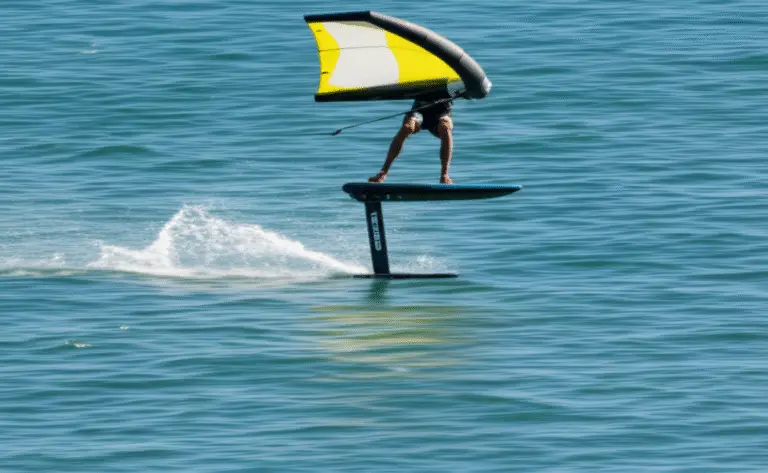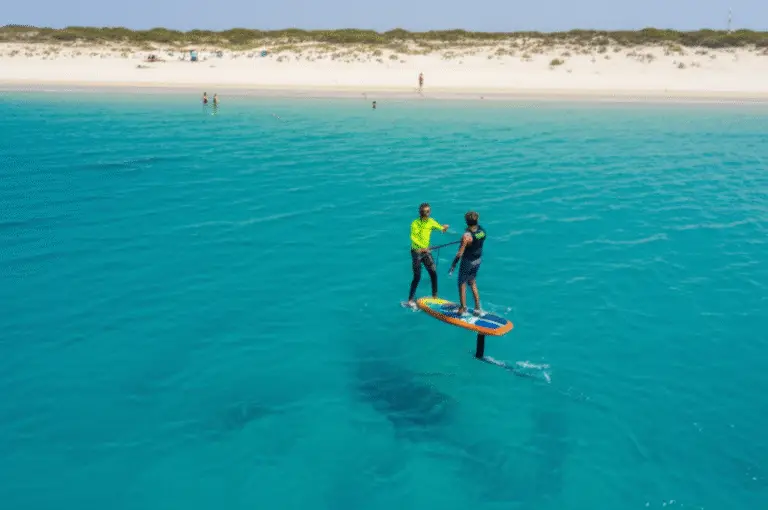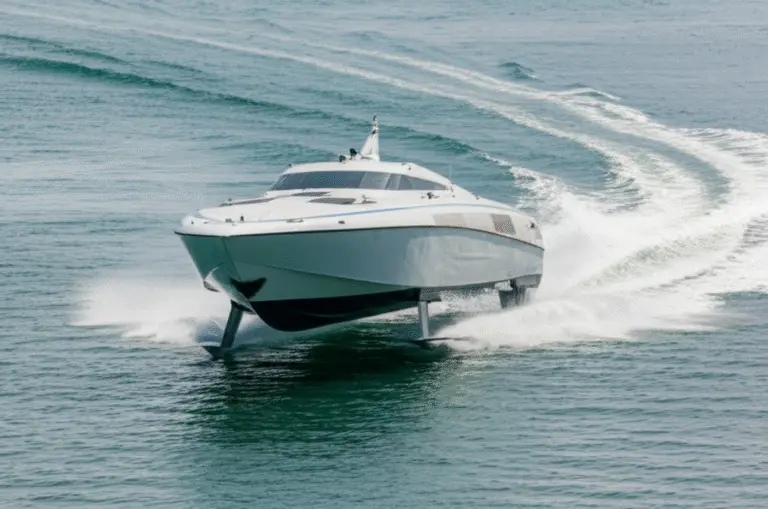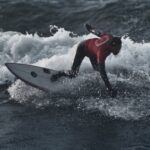Support our hydrofoil educational content for free when you purchase through links on our site. Learn more
What Kind of Boat & Gear Do You Need to Start Hydrofoiling? 🚤 (2025)
Ever watched a hydrofoil surfer seemingly fly above the water and wondered, “What kind of boat and equipment do I actually need to get started with hydrofoiling?” You’re not alone! Hydrofoiling is one of the fastest-growing water sports, blending the thrill of surfing with the speed of wakeboarding — but it comes with its own unique gear and boat requirements. Whether you’re dreaming of your first effortless glide or aiming to master the art behind a boat, this guide breaks down everything you need to know.
Here’s a little secret from our Hydrofoiling™ team: the right boat and foil setup can make the difference between a frustrating wipeout and your first magical flight above the waves. We’ll walk you through the safest, most beginner-friendly boats, the best boards and foils for easy lift, and the must-have safety gear to keep you flying high without falling hard. Plus, we’ll share pro tips, common mistakes to avoid, and how to budget smartly for your new obsession. Ready to find your perfect hydrofoiling setup? Let’s dive in!
Key Takeaways
- Choose an inboard boat like the Malibu Wakesetter or MasterCraft XStar for clean, safe wakes ideal for hydrofoiling.
- Start with a larger hydrofoil board (4’6”–5’) paired with a big wing foil (~2000 cm²) for stability and easy lift.
- Safety gear is non-negotiable: Always wear a life jacket and helmet to protect yourself from the sharp foil wings.
- Use a longer tow rope (60-70 feet) and keep speeds around 10-12 mph to find your balance and control.
- Maintenance and proper setup extend gear life and improve your riding experience.
- Rent or take lessons first if you’re unsure about investing heavily upfront.
Ready to gear up?
- 👉 Shop Hydrofoil Boards: Amazon | Slingshot Official
- Explore Hydrofoil Wings: Amazon | Lift Foils
- Find the Perfect Boat: Malibu Boats | MasterCraft Boats
Dive deeper into our full guide to start flying over water like a pro!
Table of Contents
- Quick Tips and Facts About Hydrofoiling Boats and Gear 🚤🛠️
- The Rise of Hydrofoiling: A Splash into Its Nautical Origins 🌊🛥️
- What Kind of Boat Do You Need to Start Hydrofoiling? 🚤✅
- Top 7 Boats Perfect for Hydrofoiling Beginners and Pros Alike 🚤🔥
- Essential Hydrofoiling Equipment: Boards, Foils, and More 🏄♂️🔧
- Choosing the Right Hydrofoil Setup: Size, Shape, and Materials Explained 🛠️📏
- Motors, Engines, and Tow Ropes: Powering Your Hydrofoiling Adventure ⚡🚀
- Safety Gear and Accessories: Staying Safe While Flying Over Water 🦺🌊
- Maintenance Tips: Keeping Your Hydrofoiling Boat and Gear in Tip-Top Shape 🧽🔩
- Budgeting Your Hydrofoiling Setup: What to Invest In and What to Skip 💸💡
- Common Mistakes to Avoid When Starting Hydrofoiling 🚫🤿
- Pro Tips from Hydrofoiling Experts: Insider Secrets to Get You Gliding Fast 🏄♀️✨
- Conclusion: Your First Steps Toward Hydrofoiling Mastery 🌟🏄♂️
- Recommended Links for Hydrofoiling Gear and Community 🌐🔗
- FAQ: Answering Your Burning Questions About Hydrofoiling Boats and Equipment ❓🛥️
- Reference Links: Trusted Sources to Deepen Your Hydrofoiling Knowledge 📚🔍
Quick Tips and Facts About Hydrofoiling Boats and Gear 🚤🛠️
Welcome to the thrilling world of hydrofoiling! Before you jump in (literally), here are some quick nuggets of wisdom from the Hydrofoiling™ crew to get you started on the right foot (or board):
- ✅ Boat choice: Any boat that can create a clean, surfable wake works — inboard boats are safer because the propeller is tucked underneath, away from you. Outboards? Use caution!
- ✅ Speed: Start slow, around 10-12 mph. You don’t need a monster wake to fly.
- ✅ Rope length: Longer is better — 60-70 feet gives you room to maneuver.
- ✅ Board size: Beginner foilboards are larger (4’6” to 5’) with more volume for stability.
- ✅ Foil wing size: Bigger wings (around 2000 cm²) provide more lift at slower speeds — perfect for newbies.
- ✅ Safety gear: Life jackets and helmets are a must. Trust us, falling on a foil is no joke!
- ✅ Learning method: Starting behind a boat or jet ski is a great way to feel the foil’s lift before hitting waves.
Want to dive deeper? Check out our detailed guide on hydrofoiling behind a boat for a full walkthrough.
For more basics, explore our Hydrofoil Basics section.
The Rise of Hydrofoiling: A Splash into Its Nautical Origins 🌊🛥️
Hydrofoiling isn’t just a flashy new water sport — it’s a decades-old innovation that’s been evolving steadily. The concept dates back to the early 1900s when engineers first realized that underwater wings could lift boats, reducing drag and increasing speed. Fast forward to today, and hydrofoils have revolutionized everything from competitive sailing to recreational surfing.
Why Hydrofoiling Took Off
- Reduced drag = faster, smoother rides. By lifting the hull out of the water, hydrofoils minimize resistance, letting you glide effortlessly.
- Versatility: Hydrofoiling works behind boats, jet skis, and even in waves, making it accessible to many water lovers.
- Tech advances: Carbon fiber and aluminum foils are lighter and stronger, making the sport safer and more fun.
For a deep dive into the history, visit our Hydrofoil History archive.
What Kind of Boat Do You Need to Start Hydrofoiling? 🚤✅
Choosing the right boat is like picking your trusty steed — it can make or break your hydrofoiling adventure.
Inboard vs. Outboard: The Great Debate
| Feature | Inboard Boat ✅ | Outboard Boat ❌ |
|---|---|---|
| Propeller location | Underneath, away from rider | Behind, near rider |
| Safety | Safer for hydrofoiling | Requires extra caution |
| Wake quality | Usually cleaner, surfable wake | Can be choppier, less consistent |
| Popular models | Malibu, MasterCraft, Nautique | Yamaha, Mercury, Suzuki |
Why Inboard Boats Rock: The propeller is tucked under the hull, so you’re less likely to get injured. Plus, they tend to produce a cleaner, surfable wake that’s perfect for hydrofoiling.
Outboard boats? They can work, but you’ll want to stay further away from the motor and be extra vigilant. Safety first!
Wake Size and Speed
- You don’t need a giant wake to foil — a clean, surfable wake is key.
- Start at 10-12 mph to get comfortable with the lift and balance.
- Longer tow ropes (60-70 feet) give you space to find your groove.
For a comprehensive look at boats ideal for hydrofoiling, check out our Hydrofoil Equipment Reviews.
Top 7 Boats Perfect for Hydrofoiling Beginners and Pros Alike 🚤🔥
Ready to pick your ride? Here’s our Hydrofoiling™ team’s top 7 boats that deliver the perfect wake and safety for hydrofoiling:
| Rank | Boat Model | Type | Wake Quality | Safety Features | Why We Love It |
|---|---|---|---|---|---|
| 1 | Malibu Wakesetter | Inboard | ⭐⭐⭐⭐⭐ | Propeller under hull | Industry standard, clean wake, reliable |
| 2 | MasterCraft XStar | Inboard | ⭐⭐⭐⭐⭐ | Safety propeller design | Adjustable wake, great for all levels |
| 3 | Nautique G23 | Inboard | ⭐⭐⭐⭐⭐ | Enclosed propeller | Perfect wake shaping, smooth ride |
| 4 | Axis A22 | Inboard | ⭐⭐⭐⭐ | Safety features | Budget-friendly, solid wake |
| 5 | Yamaha 242X | Outboard | ⭐⭐⭐⭐ | Caution advised | Powerful, but requires awareness |
| 6 | Supra SE | Inboard | ⭐⭐⭐⭐ | Propeller safety | Great for wake sports, versatile |
| 7 | Centurion Ri257 | Inboard | ⭐⭐⭐⭐ | Safety propeller | Reliable, smooth wake |
Pro Tip: If you’re just starting, stick with inboard boats like the Malibu or MasterCraft — they’re the gold standard for hydrofoiling wakes and safety.
Essential Hydrofoiling Equipment: Boards, Foils, and More 🏄♂️🔧
Hydrofoiling is a dance between you, your board, and your foil. Here’s the gear you’ll need to get your groove on:
Hydrofoil Boards
- Size: Beginners want larger boards (4’6” to 5’) with more volume for stability.
- Materials: Foam-core or epoxy boards are forgiving; carbon fiber boards are lighter and more responsive but pricier.
- Brands to Watch: Slingshot Space Skate, Lift Foils, and Cabrinha are favorites among our crew.
Hydrofoils
- Wing size: Larger wings (~2000 cm²) give more lift at slower speeds — perfect for newbies.
- Materials: Carbon fiber foils are lightweight and stiff; aluminum foils are durable and budget-friendly.
- Brands: Slingshot Infinity 76cm wing, Lift Foils, and Moses Hydrofoils.
Tow Ropes and Handles
- Length: 60-70 feet recommended for beginners to give space to find balance.
- Handles: Ergonomic handles reduce hand fatigue.
Safety Gear
- Life jacket (preferably impact-rated)
- Helmet (highly recommended)
- Wetsuit or impact vest for cold or rough conditions
For a full breakdown of gear, see our Hydrofoil Equipment Reviews.
Choosing the Right Hydrofoil Setup: Size, Shape, and Materials Explained 🛠️📏
Not all foils are created equal! Here’s how to pick the perfect setup:
Wing Size and Shape
| Wing Type | Lift | Speed | Stability | Best For |
|---|---|---|---|---|
| Large (2000+ cm²) | High lift | Lower top speed | Very stable | Beginners, slow speeds |
| Medium (1200-1800 cm²) | Moderate lift | Balanced speed | Moderate stability | Intermediate riders |
| Small (<1200 cm²) | Low lift | High speed | Less stable | Advanced riders |
Mast Length
- Short mast (24”/60cm): Easier control, safer for beginners.
- Long mast (28”/72cm+): More maneuvering space, better in choppy water, preferred by pros.
Materials
- Carbon fiber: Lightweight, stiff, expensive.
- Aluminum: Durable, heavier, budget-friendly.
- Composite: A mix, balancing cost and performance.
Hydrofoil Setup Ratings (Example: Slingshot Infinity 76cm Wing)
| Aspect | Rating (1-10) |
|---|---|
| Design | 9 |
| Functionality | 9 |
| Durability | 8 |
| Beginner Friendliness | 10 |
| Price Value | 8 |
Why we love it: The Slingshot Infinity wing offers massive lift for easy takeoffs, stable rides, and is built tough for years of fun.
Motors, Engines, and Tow Ropes: Powering Your Hydrofoiling Adventure ⚡🚀
If you’re starting behind a boat, here’s what you need to know about the power source:
Engine Types
- Inboard engines: Preferred for safety and wake quality.
- Outboard engines: Can work but require extra caution around the propeller.
Tow Rope Essentials
- Length: 60-70 feet recommended for beginners.
- Material: Durable, low-stretch ropes improve control.
- Handle: Ergonomic handles reduce fatigue and improve grip.
Boat Speed
- Start at 10-12 mph. Too slow and the foil won’t lift; too fast and you risk losing control.
Safety Gear and Accessories: Staying Safe While Flying Over Water 🦺🌊
Hydrofoiling is exhilarating but comes with risks. Here’s your safety checklist:
- Life jacket: Always wear a Coast Guard-approved PFD.
- Helmet: Protects your noggin from foil strikes and falls.
- Impact vest: Adds extra padding and buoyancy.
- Leash: Keeps your board close but beware of tangles around the foil.
- Gloves and booties: Optional, but great for cold water or rough conditions.
Pro Tip: Never hydrofoil alone. Always have a spotter on the boat or shore.
Maintenance Tips: Keeping Your Hydrofoiling Boat and Gear in Tip-Top Shape 🧽🔩
Your gear deserves TLC to keep flying high:
Boat Maintenance
- Rinse with fresh water after every session.
- Check propeller and hull for damage.
- Regularly inspect tow rope and handle for wear.
Hydrofoil and Board Care
- Rinse foils and boards with fresh water.
- Inspect foil wings for cracks or dents.
- Tighten all screws and bolts before each ride.
- Store boards and foils in shaded, dry places.
Budgeting Your Hydrofoiling Setup: What to Invest In and What to Skip 💸💡
Hydrofoiling can get pricey, but smart shopping helps:
| Gear Item | Invest In? | Why? |
|---|---|---|
| Board | ✅ | Stability and comfort are key for learning |
| Hydrofoil | ✅ | Quality foil = safer, smoother rides |
| Boat | ✅ | Safety and wake quality matter |
| Safety gear | ✅ | Non-negotiable for your well-being |
| Tow rope & handle | ✅ | Good rope = better control |
| Extra accessories | ❌ | Optional, can add later |
Common Mistakes to Avoid When Starting Hydrofoiling 🚫🤿
Avoid these rookie errors to save time and bruises:
- Starting too fast — slow and steady wins the race.
- Using a small foil wing — makes lift harder to control.
- Neglecting safety gear — helmets and life jackets save lives.
- Not practicing proper stance and balance — learn the tripod method!
- Ignoring boat wake quality — choppy wakes = rough rides.
Pro Tips from Hydrofoiling Experts: Insider Secrets to Get You Gliding Fast 🏄♀️✨
Our Hydrofoiling™ pros share their secrets:
- Patience is your best friend. The first few sessions are tough but stick with it!
- Use the tripod method to get up on the board — hands on rails, back foot on board, then bring front foot forward.
- Start behind a boat or jet ski to feel the foil’s lift before hitting waves.
- Choose bigger wings and bigger boards initially — less chance of wipeouts.
- Keep your weight centered and eyes forward — balance is everything.
- Take lessons from certified instructors to accelerate progress safely.
For advanced techniques, visit our Advanced Hydrofoiling Techniques page.
Ready to gear up? Check out our recommended products and brands in the next sections!
Conclusion: Your First Steps Toward Hydrofoiling Mastery 🌟🏄♂️
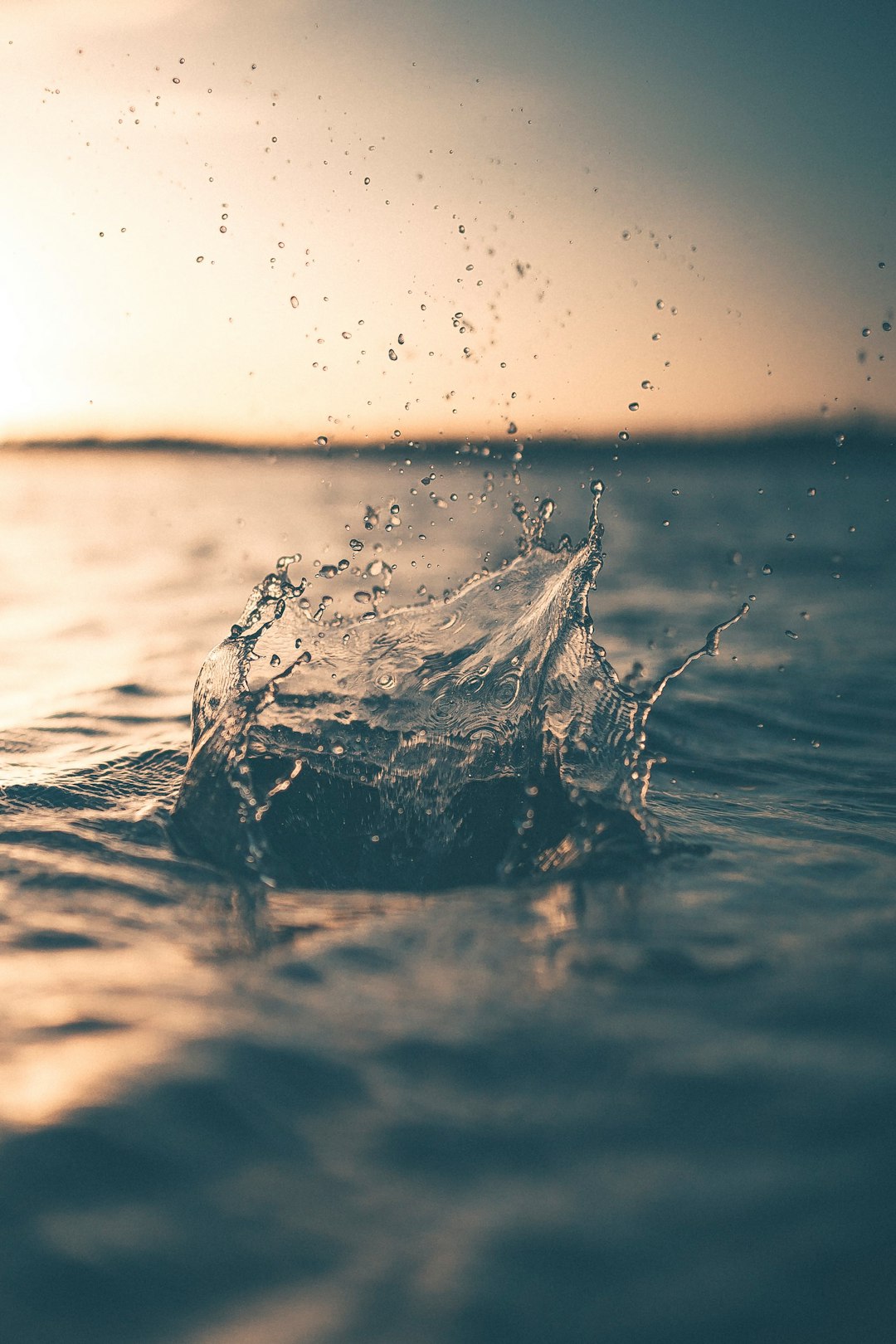
So, what kind of boat and equipment do you need to get started with hydrofoiling? The answer is delightfully flexible but with some golden rules: choose a boat that produces a clean, surfable wake, preferably an inboard for safety; pick a larger, stable foilboard with a big wing for easy lift; and never skimp on safety gear like life jackets and helmets. Starting slow at 10-12 mph with a longer tow rope gives you the space and confidence to find your balance and enjoy the magic of flying above water.
Our Hydrofoiling™ experts highly recommend the Slingshot Space Skate 4’8” board paired with the Slingshot Infinity 76cm wing for beginners. This combo offers excellent lift, stability, and durability—perfect for those first exhilarating rides. The boat? Malibu Wakesetter or MasterCraft XStar are top picks for their clean wakes and safety features.
Positives:
- Easy lift and smooth rides with the Slingshot setup
- Safe, consistent wakes from inboard boats
- Comprehensive safety gear options
- Plenty of expert tips and community support
Negatives:
- Initial investment can be steep (but worth it!)
- Outboard boats require extra caution
- Learning curve demands patience and practice
If you’ve been wondering how to get that first taste of hydrofoiling freedom, now you have the roadmap. Remember, it’s all about starting slow, choosing the right gear, and respecting the water and your limits. Soon enough, you’ll be gliding effortlessly, feeling like you’re flying on water — and trust us, that feeling is addictive!
Ready to take the plunge? Dive into our recommended gear and resources below and start your hydrofoiling journey today!
Recommended Links for Hydrofoiling Gear and Community 🌐🔗
👉 CHECK PRICE on:
- Slingshot Space Skate 4’8” Foilboard: Amazon | Slingshot Official Website
- Slingshot Infinity 76cm Wing: Amazon | Slingshot Official Website
- Malibu Wakesetter Boats: Malibu Boats Official
- MasterCraft XStar Boats: MasterCraft Official
Books to deepen your hydrofoiling knowledge:
- Hydrofoil Surfing: The Ultimate Beginner’s Guide to the Foil Surfboard by Bart’s Marine Experts — Amazon Link
- The Complete Guide to Hydrofoiling by Hydrofoiling™ Team — Amazon Link
Explore more gear reviews and tutorials at our Hydrofoil Equipment Reviews and join the conversation in our Hydrofoil Basics community.
FAQ: Answering Your Burning Questions About Hydrofoiling Boats and Equipment ❓🛥️
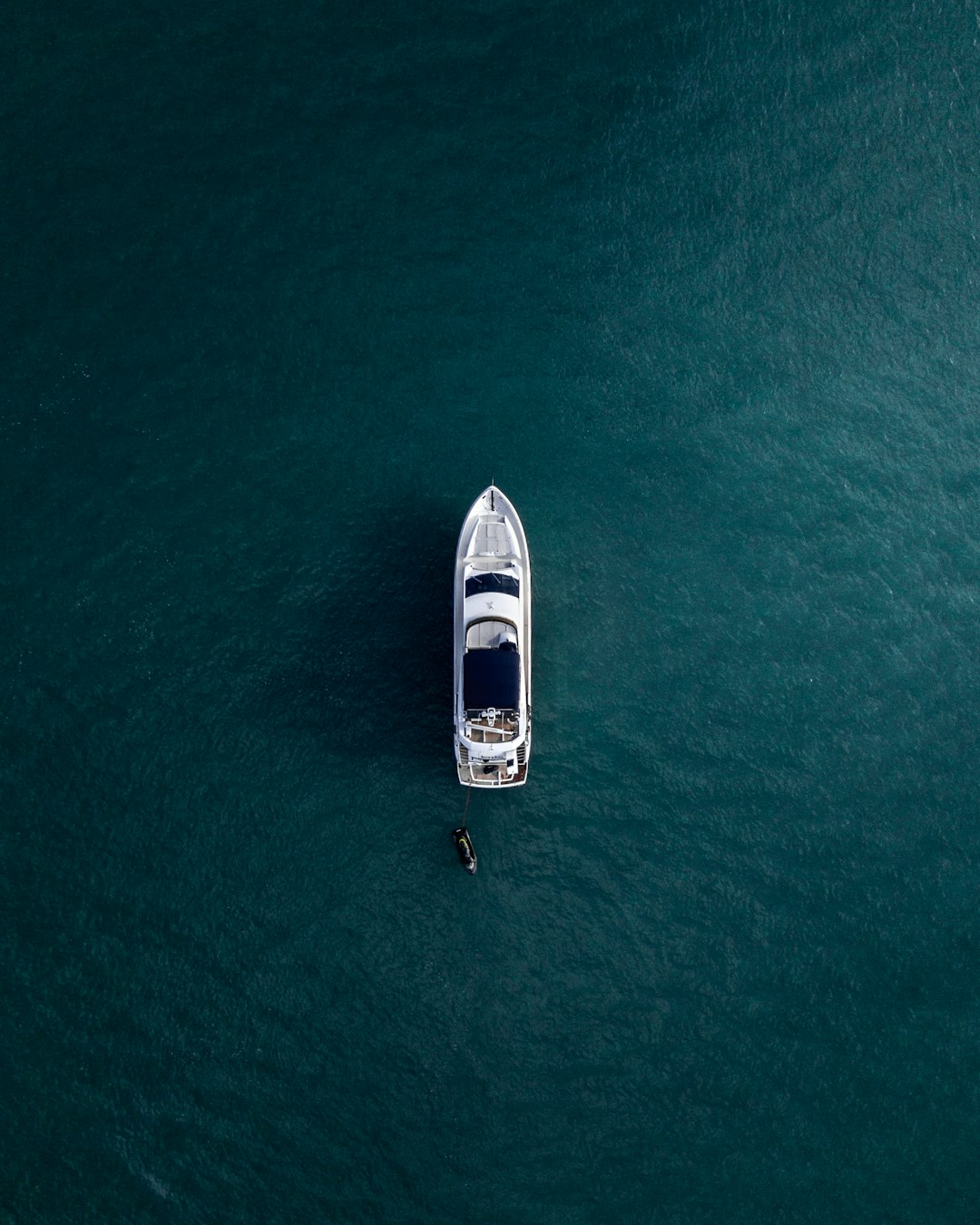
What are the key differences between a hydrofoil board and a regular surfboard that I should consider when getting started with hydrofoiling?
Hydrofoil boards differ from regular surfboards in several crucial ways:
- Size and Volume: Hydrofoil boards are generally smaller but have more volume and buoyancy to support the foil and rider during takeoff. Beginners often start with boards around 4’6” to 5’ with ample volume for stability.
- Construction: Hydrofoil boards often use stronger, stiffer materials like epoxy or carbon fiber to handle the stresses of foil mounting and lift, whereas regular surfboards may be foam or fiberglass.
- Foil Mounting: Hydrofoil boards have reinforced mounts underneath to attach the hydrofoil mast and wings securely. Regular surfboards lack this hardware.
- Riding Style: Hydrofoil boards lift above the water surface, drastically reducing drag, while regular surfboards ride on the water’s surface. This changes balance, control, and speed dynamics.
Bottom line: If you’re serious about hydrofoiling, invest in a dedicated hydrofoil board designed for stability and foil compatibility. For more on board selection, check our Hydrofoil Board Selection guides.
How much does it cost to buy a hydrofoil setup, and are there any rental or financing options available for beginners?
Hydrofoiling gear costs vary widely:
- Boards: $800 to $2,500+ depending on size and materials.
- Hydrofoils: $1,000 to $3,000+ for quality carbon or aluminum foils.
- Safety gear: $100 to $400 for helmets, life jackets, and impact vests.
- Boat: If you don’t own one, renting or joining a club with boats is common.
Rental and financing options:
- Many watersports centers and wake parks offer foilboard rentals and lessons, which is a great way to test the waters without a big upfront investment.
- Some brands and retailers provide financing plans or payment installments for boards and foils.
- Local hydrofoiling clubs often share gear or organize group buys to reduce costs.
Pro tip: Start with rentals or used gear to learn before investing heavily. Our Hydrofoil Equipment Reviews often highlight budget-friendly options.
What kind of physical conditioning and skill level do I need to have in order to learn how to hydrofoil, and are there any recommended training programs?
Hydrofoiling demands a blend of balance, core strength, and water confidence:
- Physical conditioning: Good balance and leg strength help control the foil. Core stability is crucial for maintaining posture during lift-off and turns. Cardiovascular fitness aids endurance.
- Skill level: Prior experience with surfing, wakeboarding, or paddleboarding accelerates learning but isn’t mandatory. Beginners should expect a steeper initial learning curve but rapid progression with practice.
- Training programs: Professional lessons from certified hydrofoil instructors are highly recommended. Many wake parks and watersports schools offer beginner clinics focusing on safety, stance, and foil control.
- Dryland training: Balance boards, yoga, and core workouts help prepare your body before hitting the water.
Check out our Advanced Hydrofoiling Techniques for expert tips and training drills.
Are there any specific safety precautions or gear that I should use when hydrofoiling, and how can I minimize my risk of injury while learning?
Absolutely! Hydrofoiling involves sharp foil wings and high speeds, so safety is paramount:
- Wear a Coast Guard-approved life jacket or impact vest at all times.
- Use a helmet designed for watersports to protect your head from foil impacts.
- Consider an impact vest for extra padding, especially in choppy conditions.
- Use a leash carefully: It keeps your board close but can tangle around the foil — practice safe leash management.
- Start behind a boat or jet ski with a spotter to monitor your progress and assist if needed.
- Learn the proper falling technique: Try to fall away from the foil and avoid diving headfirst.
- Inspect your gear regularly for damage or loose parts.
- Avoid crowded areas to reduce collision risks.
Following these precautions will help you enjoy hydrofoiling safely and confidently.
How do I properly get up on a hydrofoil board when starting behind a boat?
Getting up on a hydrofoil board can be tricky. Two popular methods are:
Jumping Method
- Jump with both feet at once as the boat pulls you up.
- Risky because feet placement can be off, leading to falls.
Tripod Method (Recommended)
- Place your hands on the rails of the board in the water.
- Put your back foot on the board to stabilize.
- Use your hands and back foot as a tripod for balance.
- Bring your front foot forward once stable.
This method gives you better control and reduces wipeouts. Our pros swear by it!
Read more about “10 Best Hydrofoil Boards to Fly Over Water in 2025 🌊🚀”
Can I hydrofoil in saltwater and freshwater, and does the type of water affect my equipment choice?
Yes! Hydrofoiling works in both saltwater and freshwater environments. However:
- Saltwater: Corrosive to metal parts, so rinse your gear thoroughly with fresh water after every session. Use corrosion-resistant materials like anodized aluminum or carbon fiber.
- Freshwater: Less corrosive, but still rinse to remove dirt and algae.
- Equipment choice: No major differences, but maintenance routines vary. Some foils have coatings specifically designed for saltwater durability.
Reference Links: Trusted Sources to Deepen Your Hydrofoiling Knowledge 📚🔍
- Bart’s Marine: Hydrofoil Surfing – The Ultimate Beginner’s Guide
- Slingshot Sports Official Site
- Malibu Boats Official Site
- MasterCraft Boats Official Site
- Hydrofoiling.org: Hydrofoil Basics
- Hydrofoiling.org: Hydrofoil Equipment Reviews
- Hydrofoiling.org: Advanced Hydrofoiling Techniques
- Hydrofoiling.org: Hydrofoil Board Selection
- US Coast Guard Boating Safety
Ready to ride the waves like never before? Your hydrofoiling adventure starts with the right gear, the right boat, and the right mindset. See you on the water! 🌊🏄♂️✨

